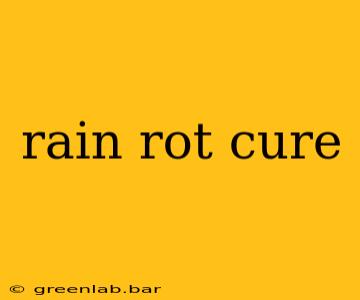Rain rot, formally known as dermatophilosis, is a common and frustrating skin condition affecting horses worldwide. Characterized by scabby, crusty lesions, it thrives in wet and humid conditions, hence its colloquial name. While not typically life-threatening, rain rot can significantly impact a horse's comfort, appearance, and overall well-being. This comprehensive guide explores the causes, symptoms, and effective treatments for rain rot, empowering horse owners to manage this prevalent skin ailment.
Understanding Rain Rot: Causes and Symptoms
Rain rot is caused by the bacterium Dermatophilus congolensis. This organism is ubiquitous in the environment, particularly in soil and water. It enters the horse's skin through minor abrasions or wounds, often exacerbated by prolonged exposure to moisture. Factors contributing to rain rot outbreaks include:
- Excessive moisture: Rain, sweat, and inadequate drying after bathing create ideal conditions for bacterial growth.
- Poor hygiene: Neglecting regular grooming and allowing dirt and debris to accumulate on the horse's coat increases the risk of infection.
- Underlying health issues: Horses with weakened immune systems are more susceptible to rain rot. Conditions like Cushing's disease or other immunosuppressive diseases can predispose a horse to this bacterial infection.
- Insect bites: Insect bites can create entry points for the bacteria.
Recognizing the Symptoms:
The hallmark signs of rain rot are:
- Scabby lesions: These are often raised, crusty, and may be yellowish or brownish in color. They typically begin as small, moist areas that quickly develop into scabs.
- Hair loss: Affected areas frequently exhibit significant hair loss, leaving the skin exposed and vulnerable.
- Itching: While not always present, some horses experience intense itching, leading to self-trauma and potential secondary infections.
- Location: Lesions commonly appear on the neck, back, flanks, and other areas exposed to the elements.
Effective Rain Rot Treatments: A Multi-pronged Approach
Treating rain rot effectively involves a combination of strategies focused on cleansing, removing scabs, and preventing recurrence. It's crucial to consult with a veterinarian before starting any treatment plan, especially if the infection is severe or widespread. They can accurately diagnose the condition and rule out other potential skin issues.
1. Thorough Cleaning and Debridement:
The initial step involves gently cleaning the affected areas to remove scabs and debris. This can be done using:
- Mild antiseptic washes: A veterinarian may recommend specific antiseptic solutions to kill the bacteria and promote healing.
- Grooming tools: A soft brush or sponge can help remove loose scabs, but avoid forceful scrubbing which may further irritate the skin.
2. Topical Medications:
Depending on the severity of the infection, your veterinarian may prescribe topical medications such as:
- Antibacterial ointments or sprays: These help directly target the Dermatophilus congolensis bacteria.
- Anti-inflammatory medications: These can reduce swelling and itching, providing relief for the horse.
3. Systemic Medications:
In cases of widespread or severe rain rot, systemic antibiotics may be necessary to control the infection. These are administered orally or intravenously and work to combat the bacteria throughout the horse's body.
4. Preventative Measures:
Preventing recurrence is vital. Key preventative measures include:
- Regular grooming: Thorough and consistent grooming removes dirt, debris, and excess moisture, minimizing the risk of infection.
- Prompt wound care: Any minor abrasions or wounds should be cleaned and treated immediately to prevent bacterial entry.
- Improved hygiene: Maintaining a clean and dry environment for the horse is essential. Provide adequate shelter and ensure proper drainage in paddocks.
- Addressing underlying health issues: Consult with a veterinarian to address any underlying health conditions that might compromise the horse's immune system.
Conclusion: A Holistic Approach to Rain Rot Management
Rain rot is a manageable condition with appropriate treatment and preventative measures. By understanding its causes, recognizing the symptoms, and implementing a comprehensive management plan in consultation with a veterinarian, horse owners can effectively address rain rot and maintain their horse's skin health and overall well-being. Remember that early intervention is key to preventing the condition from becoming severe and ensuring a quick recovery.

